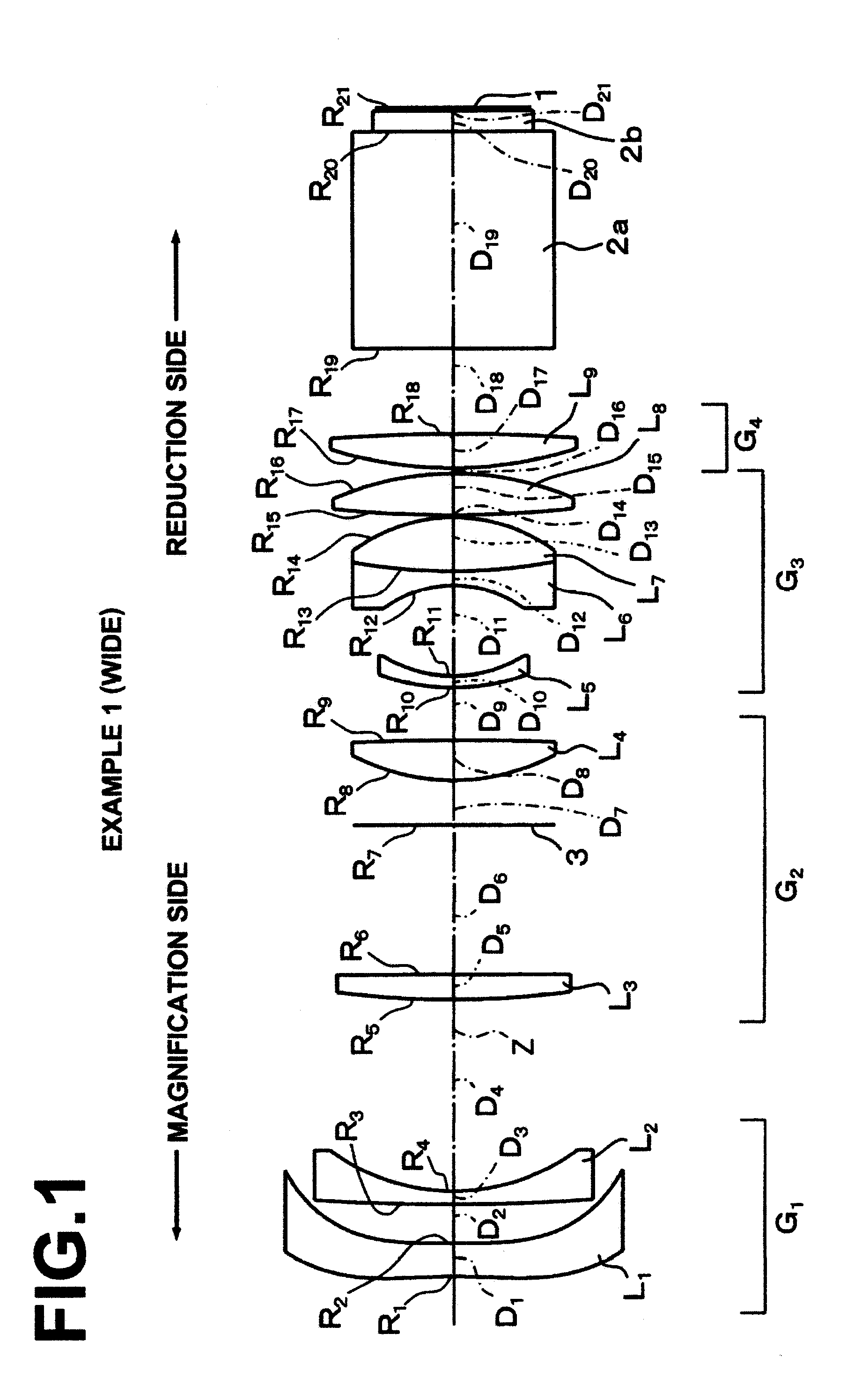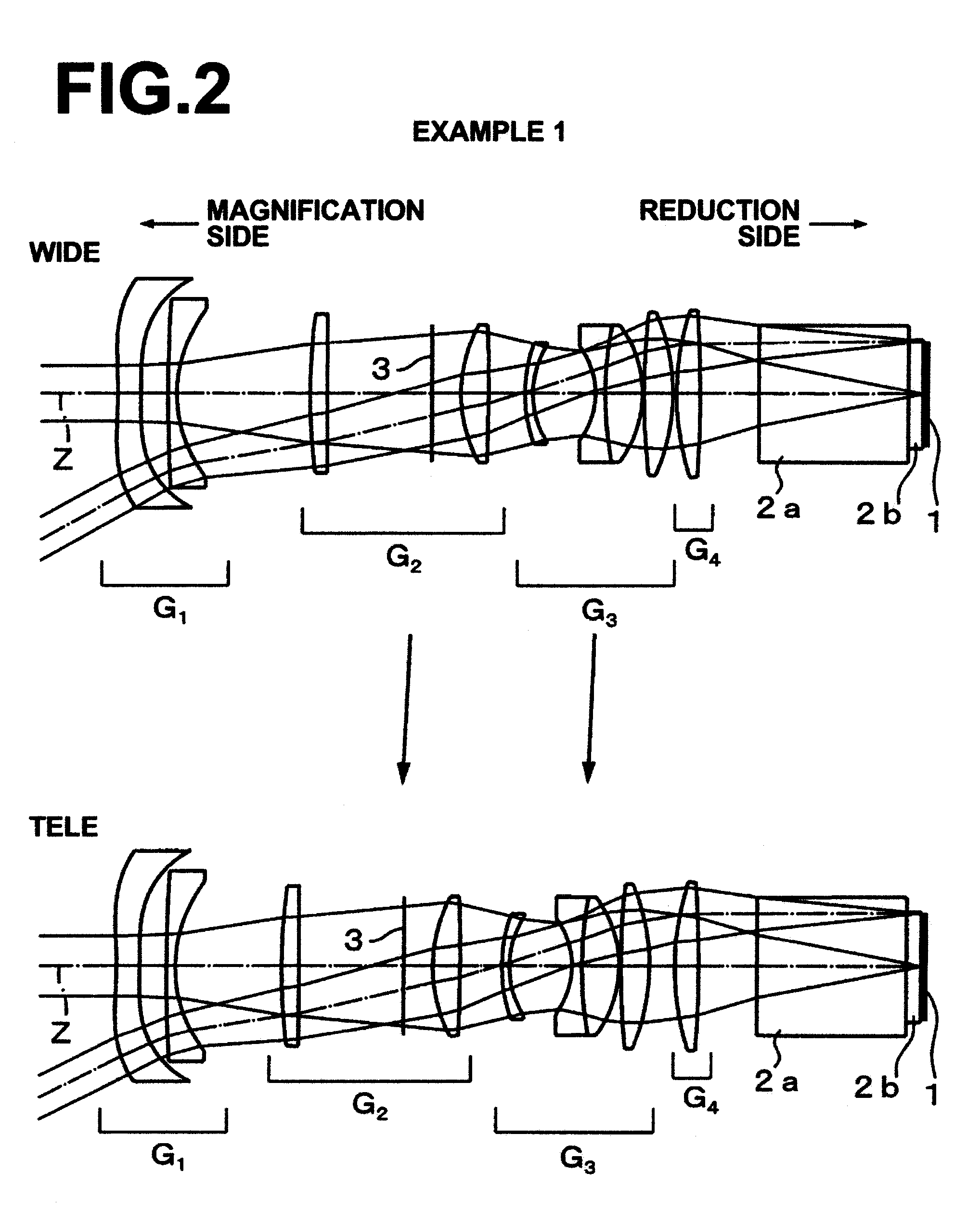Zoom lens for projection and projection-type display apparatus
- Summary
- Abstract
- Description
- Claims
- Application Information
AI Technical Summary
Benefits of technology
Problems solved by technology
Method used
Image
Examples
example 1
[0157]As described already, a zoom lens for projection in Example 1 is structured as illustrated in FIG. 1. Further, the path of movement of each movable lens group during zooming is illustrated in FIG. 2.
[0158]Specifically, in the zoom lens for projection of Example 1, lens groups and lenses are arranged from the magnification side of the zoom lens for projection in the order mentioned below. First lens group G1 is composed of first lens L1 and second lens L2. Both surfaces of the first lens L1 are aspheric, and the first lens L1 has negative meniscus shape having a concave surface facing the magnification side of the zoom lens for projection in the vicinity of optical axis Z. The second lens L2 is a negative meniscus lens having a concave surface facing the reduction side of the zoom lens for projection in the vicinity of the optical axis Z. Further, the second lens group G2 is composed of third lens L3, a mask 3, and fourth lens L4. The third lens L3 is a positive meniscus lens h...
example 2
[0167]A zoom lens for projection in Example 2 is structured as illustrated in FIG. 3. Further, the path of movement of each movable lens group during zooming is illustrated in FIG. 4.
[0168]The zoom lens for projection in Example 2 is structured in a substantially similar manner to the zoom lens for projection in Example 1. However, the zoom lens for projection in Example 2 mainly differs from the zoom lens for projection in Example 1 in that both surfaces of the first lens L1 are aspheric as in Example 1 but the first lens L1 in Example 2 has double concave shape on optical axis Z, and that the third lens L3 is a double convex lens, and that the ninth lens L9 is a positive meniscus lens having a convex surface facing the magnification side.
[0169]The upper section of Table 2 shows curvature radius R of each lens surface, center thickness D of each lens and air space D between lenses, effective diameter, and refractive index Nd and Abbe number νd of each lens for d-line in Example 2.
[...
example 3
[0175]A zoom lens for projection in Example 3 is structured as illustrated in FIG. 5. Further, the path of movement of each movable lens group during zooming is illustrated in FIG. 6.
[0176]The zoom lens for projection in Example 3 is structured in a substantially similar manner to the zoom lens for projection in Example 1. However, the zoom lens for projection in Example 3 mainly differs from the zoom lens for projection in Example 1 in that both surfaces of the first lens L1 are aspheric as in Example 1, but the first lens L1 in Example 3 has double concave shape on optical axis Z, and that a stop 3 is not provided within the lens system.
[0177]The upper section of Table 3 shows curvature radius R of each lens surface, center thickness D of each lens and air space D between lenses, effective diameter, and refractive index Nd and Abbe number νd of each lens for d-line in Example 3.
[0178]The middle section of Table 3 shows constants K and A3 through A10, which are aspheric coefficient...
PUM
 Login to View More
Login to View More Abstract
Description
Claims
Application Information
 Login to View More
Login to View More - R&D
- Intellectual Property
- Life Sciences
- Materials
- Tech Scout
- Unparalleled Data Quality
- Higher Quality Content
- 60% Fewer Hallucinations
Browse by: Latest US Patents, China's latest patents, Technical Efficacy Thesaurus, Application Domain, Technology Topic, Popular Technical Reports.
© 2025 PatSnap. All rights reserved.Legal|Privacy policy|Modern Slavery Act Transparency Statement|Sitemap|About US| Contact US: help@patsnap.com



